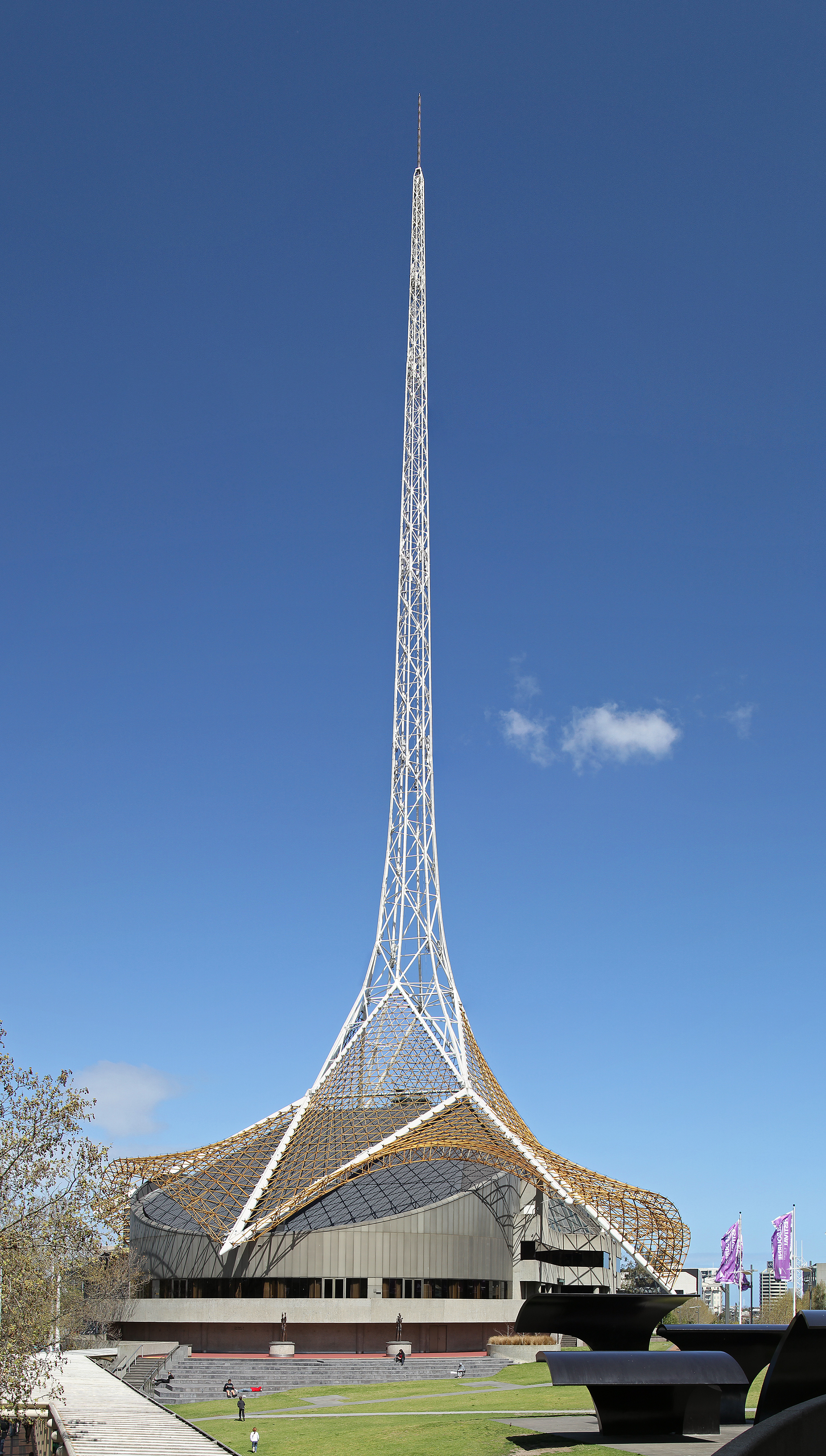
Arts Centre Melbourne
Arts Centre Melbourne, originally known as the Victorian Arts Centre and briefly called the Arts Centre, is a performing arts centre consisting of a complex of theatres and concert halls in the Melbourne Arts Precinct, located in the central Melbourne suburb of Southbank in Victoria, Australia.
"The Playhouse, Melbourne" redirects here. For the historic theatre, see Garrick Theatre (Melbourne).Arts Centre Melbourne
Victorian Arts Centre
Performing arts centre
1973
1984
Victorian Arts Centre Trust
162 m (531 ft) (was 115 m (377 ft) with original spire)
Roy Grounds and Company
Victorian Arts Centre
State Registered Place
a, b, d, e, f, g, h
August 20, 1982
H1500[1]
HO760[1]
It was designed by architect Sir Roy Grounds, the masterplan for the complex (along with the National Gallery of Victoria) was approved in 1960 and construction began in 1973 following some delays. The complex opened in stages, with Hamer Hall opening in 1982 and the Theatres Building opening in 1984.
Arts Centre Melbourne is located by the Yarra River and along St Kilda Road, one of the city's main thoroughfares, and extends into the Melbourne Arts Precinct.
Major companies regularly performing include Opera Australia, The Australian Ballet, the Melbourne Theatre Company, The Production Company, Victorian Opera, Bell Shakespeare, Bangarra Dance Theatre and the Melbourne Symphony Orchestra. Arts Centre Melbourne also hosts many Australian and international performances and production companies.
Arts Centre Melbourne is listed on the Victorian Heritage Register.
History[edit]
Background[edit]
Arts Centre Melbourne's site has long been associated with arts and entertainment; in the early 20th century it was occupied variously by a permanent circus venue, an amusement park, a cinema and a dance hall.[2] The area was a popular venue featuring the Olympia Dancing Place, the Glaciarium Ice-Skating Rink, a Japanese tea house, Snowden Gardens, the Trocadero and the Princes Court with a miniature train and water-chute. The Wirth's Circus appeared in 1907 with a 5000-seat auditorium.[3]
In the book A Place Across the River, Vicki Fairfax described the lot as a "oddly shaped piece of land" considered a sacred public spot by the locals.[3]
During World War II there was a push to establish a new home for the National Gallery of Victoria, along with a state theatre, on the site. The construction was difficult due to the triangular parcel of land the construction was planned on. However, by the 1960s, all the entertainment had left and the lot had turned into an improvised parking for city workers.[3]
Plans and construction (1960s–1970s)[edit]
After many years of discussion, Roy Grounds was chosen as the architect, and his master plan of a gallery and an adjacent theatre under a tall copper spire was approved in 1960. One of the main challenge of the construction was to dry up and retain the waters out of the base, as the construction went as deep as 7 m (23 ft) below water levels.[3] The original spire envisaged by Grounds was 115 m (377 ft) tall, and because of its complexity was one of the first structures in Australia to rely on computer-aided-design (CAD).[4]
The gallery was completed in 1968, with the theatres to be built in a second stage.
Responsibility for the project lay with the building committee, established in 1956 and chaired by Kenneth Myer from 1965 to 1989. For twenty-five years the committee was a consistent force in the completion of the complex. Actor and film director George Fairfax, having joined the project in 1972, was appointed the first general manager of the building committee and then the trust, a position he held until 1989. As a result, Fairfax played an influential role in administration of Arts Centre Melbourne's development.
In the early 1970s, due to the expansion of the size of both the theatre and the concert hall required, the addition of a smaller second theatre, and to accommodate difficulties associated with the geology of the site, Roy Grounds completely redesigned the project. The concert hall was separated out and placed in the riverbank, and the theatres building expanded above ground, with a latticework spire above.
Work began on the theatre site in 1973, but excavations were not completed until 1978, two years later than expected. Work began on the concert hall site in 1976. During the first phase of the project from 1972 until 1979 responsibility was with Rupert Hamer as Minister for the Arts (and premier)[5] and during the main construction phase from 1979 to 1982 with Norman Lacy as Minister for the Arts (and Minister of Educational Services).[6][7] After significant public controversy, political inquiry and financial reassessment,[4] the spire was completed by the Minister for the Arts, Norman Lacy, installing the lightning conductor rod at its pinnacle on 20 October 1981.[8]
Kenneth Myer Medallion for the Performing Arts[edit]
The Arts Centre presented the Kenneth Myer Medallion for the Performing Arts between 1994 and 2010.[24]
People[edit]
In August 2022 Karen Louise Quinlan AM[25] was appointed chief executive of Arts Centre Melbourne,[26] with the new role starting on 3 October 2022.[27][21]
After 18 years of director of Bendigo Art Gallery, Quinlan had headed the National Portrait Gallery in Canberra from December 2018 until September 2022. At the time of her appointment to NPGA, Quinlan was also Professor of Practice at the La Trobe Art Institute at Bendigo.[28][29] Quinlan was made a Member of the Order of Australia in the 2019 Australia Day Honours list,[30] "For significant service to the visual arts as an administrator and gallery curator, and to higher education".[25]